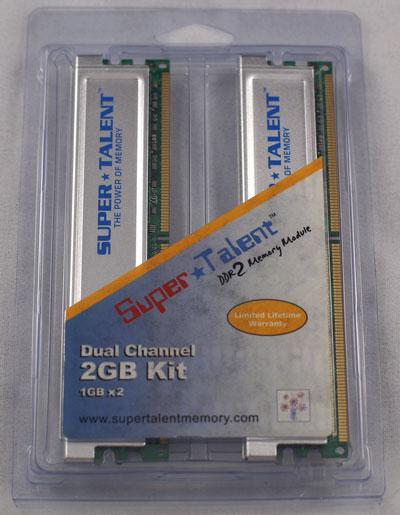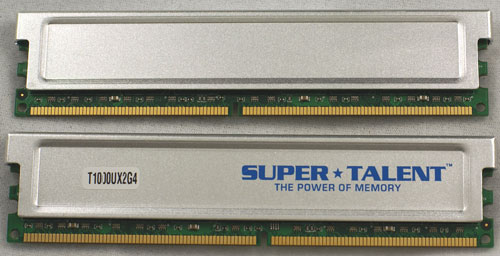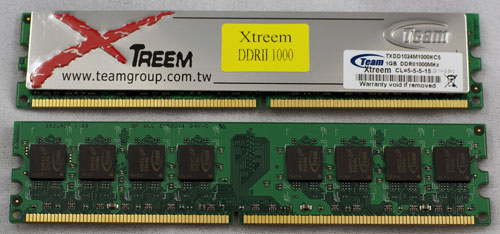Super Talent & TEAM Join the Fast DDR2 Club
by Wesley Fink on October 10, 2006 4:00 AM EST- Posted in
- Memory
Super Talent Product Specifications
Super Talent may be a new name for many, but they have been designing memory products for about 20 years. A quick look at their website will show the heavy emphasis on flash products as well as memory products. The Super Talent design center is located in San Jose, California, and their website emphasizes their US memory manufacturing facilities.
Those familiar with the memory industry may be interested in another tidbit about Super Talent. Joe James, who was formerly a key member of the Corsair Marketing team, is now at Super Talent. Certainly that says quite a lot about the directions Super Talent will likely pursue in future memory products.

One area where Super Talent definitely needs some work is packaging. The Super Talent labeling is so basic you have to look up the product code just to figure out memory speed and suggested timings. The label on the plastic clamshell looks as if it were designed by a grade-school student to be proudly displayed on the family's refrigerator. If Super Talent wants to be regarded as a serious player in the high-end memory market, they definitely need to invest in an upgraded look to their packaging.

The T1000UX2G4 was supplied as a 2GB kit with a matched pair of 1GB DIMMs. The Super Talent DIMMs feature aluminum heatspreaders with blue labeling. The DIMMs themselves are a lot more attractive than the packaging. The website pictures recent "overclocking" memory with solid blue heatspreaders. Product information is available at the Super Talent site and shows the DDR2-1000 memory is available as single 1 GB DIMMs or as a kit of two 1GB DIMMs (2GB total). We tested the 2GB kit.
The Super Talent Warranty is stated to be Lifetime, and the customer may have to provide proof of purchase. An RMA request is provided on the Super Talent website on the warranty page.
TEAM Xtreem DDRII-1000 Product Specifications
Team Group Inc. was established in Taiwan in 1994 as a manufacturer and wholesaler of computer components. TEAM is a company with a worldwide presence in memory modules, flash memory cards, and USB flash drives. All manufacturing is in Asia, but TEAM has US Sales and Marketing offices. Distribution is handled by centers in Taiwan, Hong Kong, and the USA, but TEAM plans additional distribution centers for the future.
TEAM products have performed well in past memory reviews at AnandTech, but we were a bit skeptical of how a product rated at DDR2-1000 5-5-5-15 would compare to the best DDR2 memory we have tested. As you will see in the results, the TEAM DDR2-1000 performed very well.

Compared to the very basic Super Talent design, TEAM has a distinctive Xtreem heatspreader embossed with the red Xtreem, the TEAM logo, and the web site address (www.teamgroup.com.tw). The website itself is pretty slick and full of good information about TEAM products. This even includes forums in both English and Chinese.
Test DIMMs were a 2GB kit composed of two 1GB DIMMs rated at DDR2-1000. TEAM DDR2-1000 is available as a 2GB kit (2x1GB) or as individual 1GB DIMMs.
Super Talent may be a new name for many, but they have been designing memory products for about 20 years. A quick look at their website will show the heavy emphasis on flash products as well as memory products. The Super Talent design center is located in San Jose, California, and their website emphasizes their US memory manufacturing facilities.
Those familiar with the memory industry may be interested in another tidbit about Super Talent. Joe James, who was formerly a key member of the Corsair Marketing team, is now at Super Talent. Certainly that says quite a lot about the directions Super Talent will likely pursue in future memory products.

One area where Super Talent definitely needs some work is packaging. The Super Talent labeling is so basic you have to look up the product code just to figure out memory speed and suggested timings. The label on the plastic clamshell looks as if it were designed by a grade-school student to be proudly displayed on the family's refrigerator. If Super Talent wants to be regarded as a serious player in the high-end memory market, they definitely need to invest in an upgraded look to their packaging.

The T1000UX2G4 was supplied as a 2GB kit with a matched pair of 1GB DIMMs. The Super Talent DIMMs feature aluminum heatspreaders with blue labeling. The DIMMs themselves are a lot more attractive than the packaging. The website pictures recent "overclocking" memory with solid blue heatspreaders. Product information is available at the Super Talent site and shows the DDR2-1000 memory is available as single 1 GB DIMMs or as a kit of two 1GB DIMMs (2GB total). We tested the 2GB kit.
| Super Talent T1000UX2G4 Memory Specifications | |
| Number of DIMMs & Banks | 2 DS |
| DIMM Size | 1GB |
| Total Memory | 2 GB |
| Rated Timings | 4-5-4-15 at DDR2-1000 |
| Rated Voltage | Not Specified |
The Super Talent Warranty is stated to be Lifetime, and the customer may have to provide proof of purchase. An RMA request is provided on the Super Talent website on the warranty page.
TEAM Xtreem DDRII-1000 Product Specifications
Team Group Inc. was established in Taiwan in 1994 as a manufacturer and wholesaler of computer components. TEAM is a company with a worldwide presence in memory modules, flash memory cards, and USB flash drives. All manufacturing is in Asia, but TEAM has US Sales and Marketing offices. Distribution is handled by centers in Taiwan, Hong Kong, and the USA, but TEAM plans additional distribution centers for the future.
TEAM products have performed well in past memory reviews at AnandTech, but we were a bit skeptical of how a product rated at DDR2-1000 5-5-5-15 would compare to the best DDR2 memory we have tested. As you will see in the results, the TEAM DDR2-1000 performed very well.

Compared to the very basic Super Talent design, TEAM has a distinctive Xtreem heatspreader embossed with the red Xtreem, the TEAM logo, and the web site address (www.teamgroup.com.tw). The website itself is pretty slick and full of good information about TEAM products. This even includes forums in both English and Chinese.
| TEAM TXDD2048M1000HC5DC Memory Specifications | |
| Number of DIMMs & Banks | 2 DS |
| DIMM Size | 1 GB |
| Total Memory | 2 GB |
| Rated Timings | 5-5-5-15 at DDR2-1000 |
| Rated Voltage | 2.1V to 2.3V) |
Test DIMMs were a 2GB kit composed of two 1GB DIMMs rated at DDR2-1000. TEAM DDR2-1000 is available as a 2GB kit (2x1GB) or as individual 1GB DIMMs.










16 Comments
View All Comments
PeteRoy - Tuesday, October 10, 2006 - link
Anandtech you should really stop using these graphs, their a pain to read.Wesley Fink - Tuesday, October 10, 2006 - link
Would you prefer the bar graphs like we used in past memory reviews? If so, let us know.imaheadcase - Tuesday, October 10, 2006 - link
Yes stop using these graphs. Whats the point of putting squiqly lines on a graph if the performance is pretty close to equal on memory tests you can't notice a diffrence visually? It would be diffrence if your comparing perfomance based on early computers to the latest computer..you could see a change.Stick to the bars plus numbers graphs please.
Frumious1 - Tuesday, October 10, 2006 - link
You people are friggin morons! "Oh noes! We can't read the graph! Please make a goddamn huge ass page with EIGHTEEN graphs instead of three useful charts!" They even give you the numbers at the bottom - is it THAT HARD!?!? Well, for you two, probably, but PLEASE AnandTech, stick with charts like this where it makes sense.Allow me to demonstrate how much less desirable separating the data would be, by using as an example Half-Life 2: Lost Cost. Here you go, all 6 settings put into in-duh-vidual charts:
http://i115.photobucket.com/albums/n284/frumious1/...">DDR2-400
http://i115.photobucket.com/albums/n284/frumious1/...">DDR2-533
http://i115.photobucket.com/albums/n284/frumious1/...">DDR2-667
http://i115.photobucket.com/albums/n284/frumious1/...">DDR2-800
http://i115.photobucket.com/albums/n284/frumious1/...">DDR2-1067
http://i115.photobucket.com/albums/n284/frumious1/...">Maximum Performance (OC)
Isn't that GREAT!? I mean, now we can't easily see how performance is affected going from DDR2-400 to 533 to 667, etc. If you want to whine about non-zero-based charts, whatever. Mine are zero-based, and as you can see there's not a whole hell of a lot of difference past DDR2-800. In fact, there's not much of a difference from DDR2-400 through maximum OC performance... 8.8% more performance from minimum (Super Talent DDR2-400) to maximum (OCZ/Team Highest). Great!
Know what? ALL OF THAT DATA WAS ALREADY CLEARLY VISIBLE IN ONE CHART!
Please, go back to junior high and retake some of those math classes, because clearly they didn't stick.
theprodigalrebel - Tuesday, October 10, 2006 - link
I see nothing wrong with the graphs in this article. For instance, I see a green line (TEAM) stand out at DDR2-667 for the first two tests & stand out again at DDR2-533 in Q4. It is more or less tied with the others. This is useful information. I don't care about 1-3% differences (which could very well be nominal variance) - that means, just buy whatever is cheaper.Why would I need bar graphs that detail performance variances as tiny as .16 frames per second?
imaheadcase - Tuesday, October 10, 2006 - link
Most people would rather glance and pure numbers than any graphs. You would take LESS space than what they use now.Shortass - Tuesday, October 10, 2006 - link
Well the graphs are certainly a little harder to read than large bar graphs, but I enjoy them more since it compresses a lot of information into a smaller space and you can see on one graph the entire set of tests (easier comparison and taking a few extra seconds to read the data is much better than scrolling down a massive page trying to remember the numbers each scored at different speeds, etc).Guuts - Tuesday, October 10, 2006 - link
It would be nice if you could include some "value" RAM in with these performance RAM reviews for comparison. Instead of just talking about how you need to use fairly decent timings if you want to run the modules at 1067 to see a performance advantage, why don't you add in some actual value DDR2-800 RAM that maybe can only run 5-5-5 @ 1067 and 4-3-4 @ 800 (or whatever they can do these days) so we can see just how much performance we're going to lose if we want to save 100$ on RAM? Just how much performance is lost by having looser timings at the same speed?I love performance parts, and want the best components I can afford, but I can't justify paying 50% more for a 5% increase in performance (or +5 FPS) that I'm never going to even be able to notice in real-world use. Note that I said that *I'M* not going to notice, before you start flaming me...
Good article though!
deathwalker - Tuesday, October 10, 2006 - link
Careful guy...there are flaming hound-dogs just lurking around out there waiting for value minded people like you and I. But in defense of the article it was not created with the intent to satisfy that niche. Check out this AT article for some value ram suggestions..http://www.anandtech.com/mb/showdoc.aspx?i=2797">http://www.anandtech.com/mb/showdoc.aspx?i=2797Guuts - Tuesday, October 10, 2006 - link
Yes, thanks, I've read that one... increasing the voltage and loosening tbe timings on DDR2-667 is a little TOO value. I was basically asking what one could do with some value DDR2-800 running at 1067 and how much of a performance hit would be incurred by the loose timings you'd have to use, or even the performance of value DDR2-800 with 4-4-4 timings.Sure that article shows what you could do with that Value RAM as far as pushing the speed and tweaking the timings, but I don't see any performance numbers, nor any comparisons between different timings at the same speeds...which seems pretty important since the price of memory starts to really climb the tighter the timings are at a certain speed. I'd just like to know how much performance one loses between 3-3-3, 4-4-4, and 5-5-5 with DDR2-800, for example, because I sure know how much the price difference is.
I can see the small difference in the TEAM memory vs. the slightly looser timed Super Talent memory, but I can't remember ever reading about the performance differences between more widely varied timings and was curious to see just how much of a hit it makes on the new Core 2 Duo platforms...especially with memory prices what they are today, and 2GB kits seemingly being the recommended "standard" configuration in new systems.